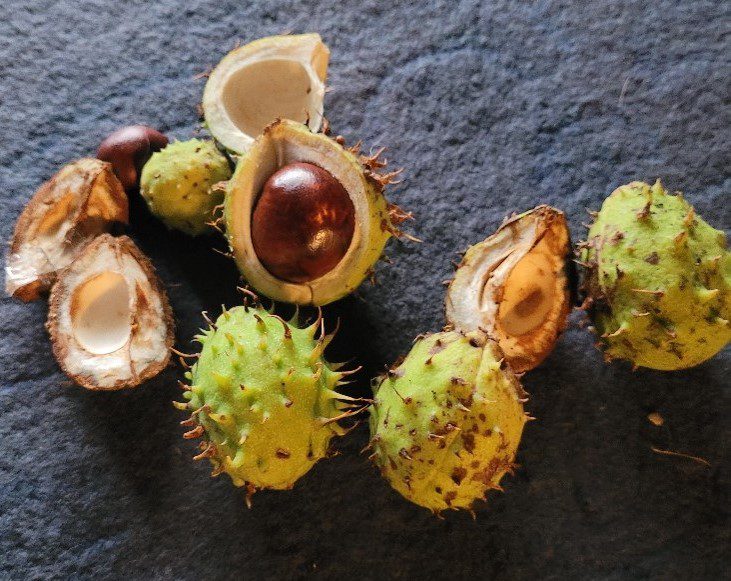Did you know that a common ornamental tree can be used both as a dye and as a scouring agent? VIF member Bobbie Williams has been experimenting with using materials she finds on her daily walks. Read about horse chestnuts below!
by Bobbie Williams
European Horse Chestnut trees (Aesculus hippocastanum) are large deciduous boulevard trees planted all over Victoria and southern Vancouver Island. The tree produces toxic nuts, known as conkers, which are encased in prickly husks. In late summer and early fall, the trees will be dropping their conkers and the sidewalks and boulevards can become obstacle courses.
While we cannot eat the nuts, the trees have other virtues. Horse Chestnuts are a member of the soapberry family, and the conkers contain saponin, which you can easily process into soap for washing clothing. The husks are high in tannin and, when used with an alum mordant at 15% WOF, I have achieved a brown colour on wool yarn which so far, has been lightfast. I have not tried this as a dye on plant fibre, but I have read reports that it also works with those materials.
You can search through Google for instructions on Soap-making with Conkers and Dyeing with Horse Chestnuts.
The first chore for both these activities is to start collecting the conkers and husks. This is typically easy in the autumn since the tripping hazards are everywhere! When you get a large bucket full, separate the conkers from the husks. I chop up the conkers and fill a large mason jar with them, and then add boiling water. Once cool, I place the jar in the ‘fridge, and by the next day I have a milky solution. That is your detergent, and you can add the liquid directly to your washing machine. I have not tried re-using the conkers – usually just dump them into the compost. If you want to store the conkers for months of soap making, it is best to cut them up and then dry them on a sheet in the oven to remove as much moisture as possible. This keeps them from molding. For my experiments I have not peeled the brown skin off the conkers, but I have read some blogs that recommend that be done.
For dyeing with the husks, I collect buckets of husks (no conkers), bring them to a boil, let sit and cool overnight or longer, and then strain the liquid from the husks. Once again, the husks can go into the compost, and you use the liquid. Some blogs recommend ageing the husks before processing, other blogs say use the green ones. I have used the green ones and achieved the colour I wanted. But if someone has access to lots of Horse Chestnut trees, this would be a good experiment!
Have fun.

